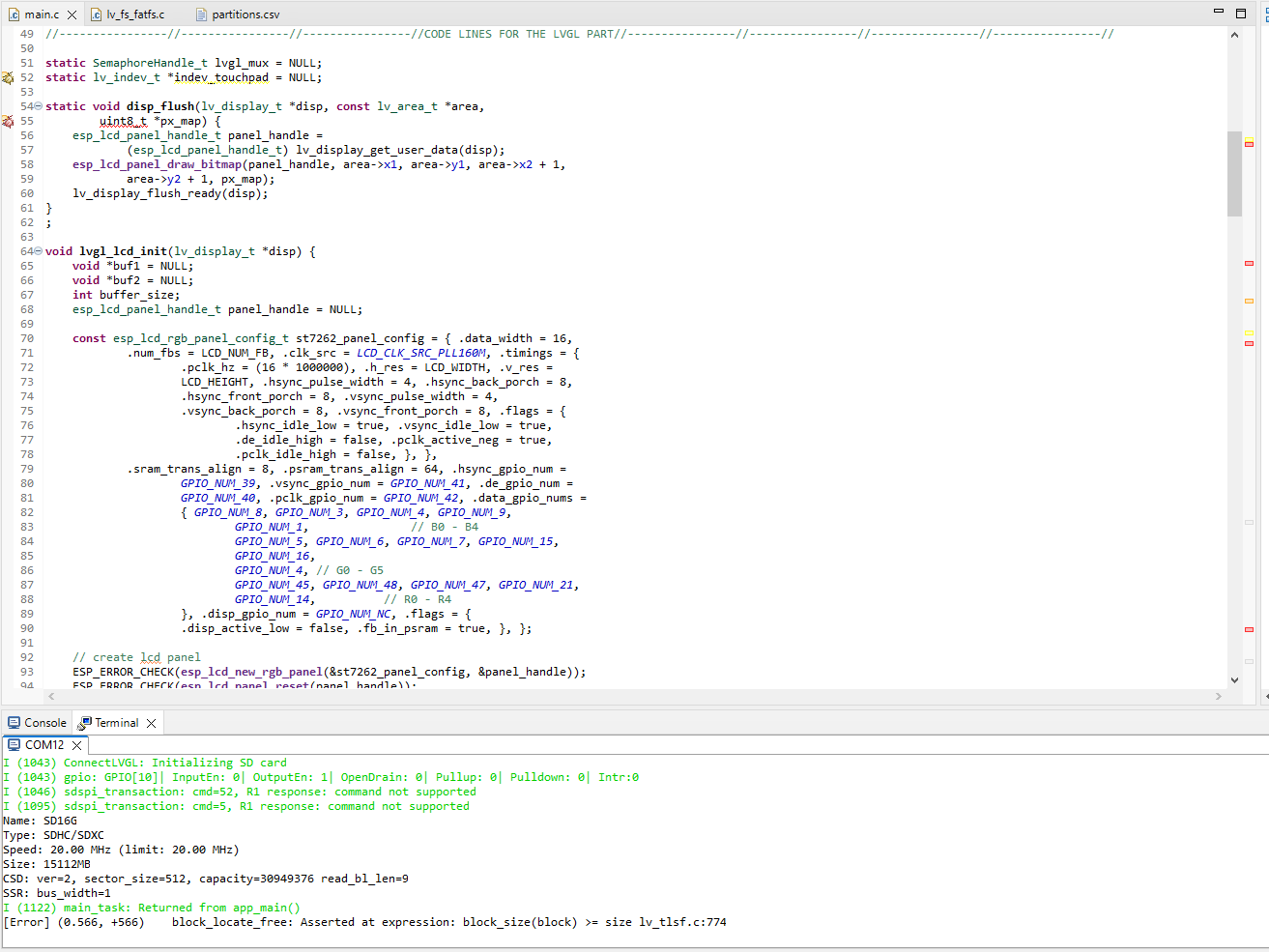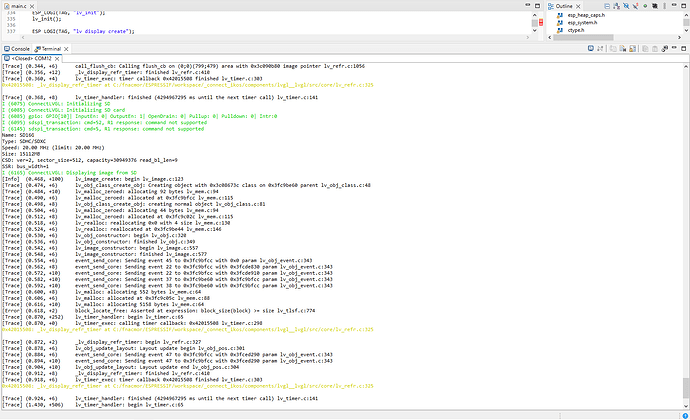Description
My project is a 800x480 screen in a board that also includes a microSD slot, so, my goal is to load images from the microSD to the screen, my code compiles and works on the ESP32-S3, but I always get white screen and the same error:
[Error] (0.566, +566) block_locate_free: Asserted at expression: block_size(block) >= size lv_tlsf.c:774
What MCU/Processor/Board and compiler are you using?
I am using ESP32-S3 with Espressif IDE 5.1
What LVGL version are you using?
I am using LVGL 9.1.0
What do you want to achieve?
I want lo show on screen an image loaded from the microSD card
What have you tried so far?
- Increasing LV_MEM_SIZE
- Changing values on lvconf
Code to reproduce
#define LCD_WIDTH 800
#define LCD_HEIGHT 480
#define LCD_NUM_FB 2
#define LCD_GPIO_BCKL GPIO_NUM_2
#define EXAMPLE_MAX_CHAR_SIZE 64
#define LV_USE_FS_FATFS 1
size_t imgsize;
static const char *TAG = "ConnectLVGL";
#define MOUNT_POINT "/sdcard"
// Pin assignments can be set in menuconfig, see "SD SPI Example Configuration" menu.
// You can also change the pin assignments here by changing the following 4 lines.
#define PIN_NUM_MISO 13
#define PIN_NUM_MOSI 11
#define PIN_NUM_CLK 12
#define PIN_NUM_CS 10 //10
//----------------//----------------//----------------//CODE LINES FOR THE LVGL PART//----------------//----------------//----------------//----------------//
static SemaphoreHandle_t lvgl_mux = NULL;
static lv_indev_t *indev_touchpad = NULL;
static void disp_flush(lv_display_t *disp, const lv_area_t *area,
uint8_t *px_map) {
esp_lcd_panel_handle_t panel_handle =
(esp_lcd_panel_handle_t) lv_display_get_user_data(disp);
esp_lcd_panel_draw_bitmap(panel_handle, area->x1, area->y1, area->x2 + 1,
area->y2 + 1, px_map);
lv_display_flush_ready(disp);
}
;
void lvgl_lcd_init(lv_display_t *disp) {
void *buf1 = NULL;
void *buf2 = NULL;
int buffer_size;
esp_lcd_panel_handle_t panel_handle = NULL;
const esp_lcd_rgb_panel_config_t st7262_panel_config = { .data_width = 16,
.num_fbs = LCD_NUM_FB, .clk_src = LCD_CLK_SRC_PLL160M, .timings = {
.pclk_hz = (16 * 1000000), .h_res = LCD_WIDTH, .v_res =
LCD_HEIGHT, .hsync_pulse_width = 4, .hsync_back_porch = 8,
.hsync_front_porch = 8, .vsync_pulse_width = 4,
.vsync_back_porch = 8, .vsync_front_porch = 8, .flags = {
.hsync_idle_low = true, .vsync_idle_low = true,
.de_idle_high = false, .pclk_active_neg = true,
.pclk_idle_high = false, }, },
.sram_trans_align = 8, .psram_trans_align = 64, .hsync_gpio_num =
GPIO_NUM_39, .vsync_gpio_num = GPIO_NUM_41, .de_gpio_num =
GPIO_NUM_40, .pclk_gpio_num = GPIO_NUM_42, .data_gpio_nums =
{ GPIO_NUM_8, GPIO_NUM_3, GPIO_NUM_4, GPIO_NUM_9,
GPIO_NUM_1, // B0 - B4
GPIO_NUM_5, GPIO_NUM_6, GPIO_NUM_7, GPIO_NUM_15,
GPIO_NUM_16,
GPIO_NUM_4, // G0 - G5
GPIO_NUM_45, GPIO_NUM_48, GPIO_NUM_47, GPIO_NUM_21,
GPIO_NUM_14, // R0 - R4
}, .disp_gpio_num = GPIO_NUM_NC, .flags = {
.disp_active_low = false, .fb_in_psram = true, }, };
// create lcd panel
ESP_ERROR_CHECK(esp_lcd_new_rgb_panel(&st7262_panel_config, &panel_handle));
ESP_ERROR_CHECK(esp_lcd_panel_reset(panel_handle));
ESP_ERROR_CHECK(esp_lcd_panel_init(panel_handle));
// assign callback and handle
lv_display_set_user_data(disp, panel_handle);
lv_display_set_flush_cb(disp, disp_flush);
#if LCD_NUM_FB == 2
buffer_size = LCD_WIDTH * LCD_HEIGHT * 2; // 2 = 16bit color data
esp_lcd_rgb_panel_get_frame_buffer(panel_handle, 2, &buf1, &buf2);
lv_display_set_buffers(disp, buf1, buf2, buffer_size,
LV_DISPLAY_RENDER_MODE_FULL);
#else
buffer_size = LCD_WIDTH * LCD_HEIGHT / 4;
buf1 = heap_caps_malloc(sizeof(lv_color_t) * buffer_size, MALLOC_CAP_SPIRAM);
lv_display_set_buffers(disp, buf1, buf2, buffer_size, LV_DISPLAY_RENDER_MODE_PARTIAL);
#endif
}
uint16_t map(uint16_t n, uint16_t in_min, uint16_t in_max, uint16_t out_min,
uint16_t out_max) {
return (n - in_min) * (out_max - out_min) / (in_max - in_min) + out_min;
}
void process_coordinates(esp_lcd_touch_handle_t tp, uint16_t *x, uint16_t *y,
uint16_t *strength, uint8_t *point_num, uint8_t max_point_num) {
*x = map(*x, 0, LCD_WIDTH, 0, LCD_WIDTH);
*y = map(*y, 0, LCD_HEIGHT, 0, LCD_HEIGHT);
}
esp_lcd_touch_handle_t lvgl_touch_init(void) {
ESP_LOGI(TAG, "Init Touch driver");
i2c_master_bus_handle_t touch_i2c_bus_handle = NULL;
const i2c_master_bus_config_t touch_i2c_bus_config = { .clk_source =
I2C_CLK_SRC_DEFAULT, .i2c_port = -1, .scl_io_num = GPIO_NUM_20,
.sda_io_num = GPIO_NUM_19, .glitch_ignore_cnt = 7, };
ESP_ERROR_CHECK(
i2c_new_master_bus(&touch_i2c_bus_config, &touch_i2c_bus_handle));
esp_lcd_panel_io_handle_t gt911_touch_io_handle = NULL;
const esp_lcd_panel_io_i2c_config_t gt911_touch_io_config = { .dev_addr =
ESP_LCD_TOUCH_IO_I2C_GT911_ADDRESS, .on_color_trans_done = NULL, .user_ctx =
NULL, .control_phase_bytes = 1, .dc_bit_offset = 0, .lcd_cmd_bits = 16,
.lcd_param_bits = 0, .flags = { .dc_low_on_data = 0,
.disable_control_phase = 1, }, .scl_speed_hz = 400000, };
ESP_ERROR_CHECK(
esp_lcd_new_panel_io_i2c(touch_i2c_bus_handle, >911_touch_io_config, >911_touch_io_handle));
esp_lcd_touch_handle_t touch_handle = NULL;
const esp_lcd_touch_config_t gt911_touch_cfg = { .x_max = LCD_WIDTH,
.y_max = LCD_HEIGHT, .rst_gpio_num = GPIO_NUM_38, .int_gpio_num =
GPIO_NUM_NC, .levels = { .reset = 0, .interrupt = 0, },
.flags = { .swap_xy = 0, .mirror_x = 0, .mirror_y = 0, },
.process_coordinates = process_coordinates, // callback to fix coordinates between gt911 and display
.interrupt_callback = NULL, };
ESP_ERROR_CHECK(
esp_lcd_touch_new_i2c_gt911(gt911_touch_io_handle, >911_touch_cfg,
&touch_handle));
return touch_handle;
}
static void gt911_touchpad_read(lv_indev_t *indev, lv_indev_data_t *data) {
esp_lcd_touch_handle_t tp = (esp_lcd_touch_handle_t) lv_indev_get_user_data(
indev);
uint16_t touchpad_x;
uint16_t touchpad_y;
uint8_t touchpad_cnt = 0;
esp_lcd_touch_read_data(tp);
bool touchpad_pressed = esp_lcd_touch_get_coordinates(tp, &touchpad_x,
&touchpad_y, NULL, &touchpad_cnt, 1);
if (touchpad_pressed && touchpad_cnt > 0) {
data->point.x = touchpad_x;
data->point.y = touchpad_y;
data->state = LV_INDEV_STATE_PRESSED;
} else {
data->state = LV_INDEV_STATE_RELEASED;
}
}
#define LVGL_TICK_PERIOD_MS 2
#define LVGL_TASK_MAX_DELAY_MS 500
#define LVGL_TASK_MIN_DELAY_MS 1
#define LVGL_TASK_STACK_SIZE (8 * 1024)
#define LVGL_TASK_PRIORITY 2
bool lvgl_lock(int timeout_ms) {
// Convert timeout in milliseconds to FreeRTOS ticks
// If `timeout_ms` is set to -1, the program will block until the condition is met
const TickType_t timeout_ticks =
(timeout_ms == -1) ? portMAX_DELAY : pdMS_TO_TICKS(timeout_ms);
return xSemaphoreTakeRecursive(lvgl_mux, timeout_ticks) == pdTRUE;
}
void lvgl_unlock(void) {
xSemaphoreGiveRecursive(lvgl_mux);
}
static void lvgl_port_task(void *arg) {
uint32_t task_delay_ms = LVGL_TASK_MAX_DELAY_MS;
while (1) {
// Lock the mutex due to the LVGL APIs are not thread-safe
if (lvgl_lock(-1)) {
task_delay_ms = lv_timer_handler();
// Release the mutex
lvgl_unlock();
}
if (task_delay_ms > LVGL_TASK_MAX_DELAY_MS) {
task_delay_ms = LVGL_TASK_MAX_DELAY_MS;
} else if (task_delay_ms < LVGL_TASK_MIN_DELAY_MS) {
task_delay_ms = LVGL_TASK_MIN_DELAY_MS;
}
vTaskDelay(pdMS_TO_TICKS(task_delay_ms));
}
}
static void lvgl_tick(void *arg) {
/* Tell LVGL how many milliseconds has elapsed */
lv_tick_inc(LVGL_TICK_PERIOD_MS);
}
const esp_task_wdt_config_t wdtConfig = { .timeout_ms = 510000, // timeout: 8.5 min
.idle_core_mask = 1 << 0 | 1 << 1, // Root PRO & APP
.trigger_panic = 1, // Reset on
};
//----------------//----------------//----------------//CODE LINES FOR THE MICROSD PART//----------------//----------------//----------------//----------------//
void init_sd_card(void) {
esp_err_t ret;
sdmmc_card_t *card;
const char mount_point[] = MOUNT_POINT;
ESP_LOGI(TAG, "Initializing SD card");
esp_vfs_fat_sdmmc_mount_config_t mount_config = { .format_if_mount_failed =
false, .max_files = 5, .allocation_unit_size = 16 * 1024 };
sdmmc_host_t host = SDSPI_HOST_DEFAULT();
spi_bus_config_t bus_cfg = { .mosi_io_num = PIN_NUM_MOSI, .miso_io_num =
PIN_NUM_MISO, .sclk_io_num = PIN_NUM_CLK, .quadwp_io_num = -1,
.quadhd_io_num = -1, .max_transfer_sz = 4000, };
ret = spi_bus_initialize(host.slot, &bus_cfg, SPI_DMA_CH_AUTO);
if (ret != ESP_OK) {
ESP_LOGE(TAG, "Failed to initialize bus.");
return;
}
sdspi_device_config_t slot_config = SDSPI_DEVICE_CONFIG_DEFAULT();
slot_config.gpio_cs = PIN_NUM_CS;
slot_config.host_id = host.slot;
ret = esp_vfs_fat_sdspi_mount(mount_point, &host, &slot_config,
&mount_config, &card);
if (ret != ESP_OK) {
ESP_LOGE(TAG, "Failed to mount filesystem.");
return;
}
sdmmc_card_print_info(stdout, card);
}
void display_image_from_sd() {
lv_obj_t *img;
img = lv_img_create(lv_scr_act());
lv_img_set_src(img, "A:/files/ikarus.png");
// Optional: Error handling
if (img == NULL) {
ESP_LOGE(TAG, "Failed to create image object");
}
lv_obj_align(img, LV_ALIGN_CENTER, 0, 0);
}
//----------------//----------------//----------------//APP MAIN//----------------//----------------//----------------//----------------//
void app_main(void) {
//----------------////----------------//LVGL PART//----------------////----------------//
esp_task_wdt_reconfigure(&wdtConfig);
ESP_LOGI(TAG, "Turn on LCD backlight");
ledc_timer_config_t ledc_timer = { .speed_mode = LEDC_LOW_SPEED_MODE,
.duty_resolution = LEDC_TIMER_8_BIT, .timer_num = LEDC_TIMER_0,
.freq_hz = 4000, // Set output frequency at 4 kHz
.clk_cfg = LEDC_USE_RC_FAST_CLK };
ESP_ERROR_CHECK(ledc_timer_config(&ledc_timer));
// Prepare and then apply the LEDC PWM channel configuration
ledc_channel_config_t ledc_channel = { .gpio_num = LCD_GPIO_BCKL,
.speed_mode = LEDC_LOW_SPEED_MODE, .channel = LEDC_CHANNEL_0,
.intr_type = LEDC_INTR_DISABLE, .timer_sel = LEDC_TIMER_0,
.duty = 0, // Set duty to 0%
.hpoint = 0 };
ESP_ERROR_CHECK(ledc_channel_config(&ledc_channel));
ledc_set_duty(LEDC_LOW_SPEED_MODE, LEDC_CHANNEL_0,
(uint32_t) (256 / (100 / 100.00)) - 1);
ledc_update_duty(LEDC_LOW_SPEED_MODE, LEDC_CHANNEL_0);
ESP_LOGI(TAG, "lv_init");
lv_init();
ESP_LOGI(TAG, "lv_display_create");
lv_display_t *disp = lv_display_create(LCD_WIDTH, LCD_HEIGHT);
ESP_LOGI(TAG, "lvgl_lcd_init");
lvgl_lcd_init(disp);
ESP_LOGI(TAG, "Install LVGL tick timer");
// Tick interface for LVGL (using esp_timer to generate 2ms periodic event)
const esp_timer_create_args_t lvgl_tick_timer_args = { .callback =
&lvgl_tick, .name = "lvgl_tick" };
esp_timer_handle_t lvgl_tick_timer = NULL;
ESP_ERROR_CHECK(esp_timer_create(&lvgl_tick_timer_args, &lvgl_tick_timer));
ESP_ERROR_CHECK(
esp_timer_start_periodic(lvgl_tick_timer, LVGL_TICK_PERIOD_MS * 1000));
ESP_LOGI(TAG, "Create LVGL task");
lvgl_mux = xSemaphoreCreateRecursiveMutex();
assert(lvgl_mux);
xTaskCreate(lvgl_port_task, "LVGL", LVGL_TASK_STACK_SIZE, NULL,
LVGL_TASK_PRIORITY, NULL);
/*
// init touch i2c bus
esp_lcd_touch_handle_t touch_handle = lvgl_touch_init();
indev_touchpad = lv_indev_create();
lv_indev_set_type(indev_touchpad, LV_INDEV_TYPE_POINTER);
lv_indev_set_user_data(indev_touchpad, touch_handle);
lv_indev_set_read_cb(indev_touchpad, gt911_touchpad_read);
*/
//lv_demo_widgets();
//ui_init();
//----------------////----------------//MICROSD PART//----------------////----------------//
// Initialize LVGL file system interface
init_sd_card();
display_image_from_sd();
// RUN UI //
//ui_init();
}

